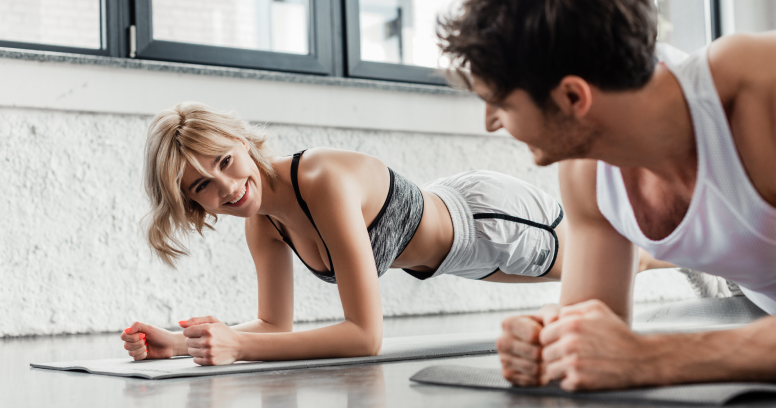Can intermittent fasting lead to muscle loss?

When you’re weighing up a new weight loss or wellness strategy, you need to think through the cons as well as the pros.
Here’s a quick ‘n easy shortcut:
If one of the cons of whatever you’re considering turns out to be muscle loss, run away.

Our bodies need muscle. Without it, disease risk and dysfunction go up, and health and performance go down. It’s harder to reach and maintain your optimal body weight. You’re more at risk of falls and injury, especially as you get older. Muscle isn’t just for strongmen and Love Island contestants. It’s essential for everyone.
So, let’s address the elephant in the room — does intermittent fasting cause muscle loss?
You’re right to wonder. Data shows that roughly 25%–33% of the weight lost through restricting calories for long periods — which sounds a lot like fasting — tends to be muscle loss.[1]
And yes, intermittent fasting can lead to muscle loss — but it doesn’t have to. You can keep ALLLLL your muscle — even while you’re fasting, even while you’re losing fat — with a few simple strategies.
Want to know how? Let’s get into it!
Intermittent fasting and muscle mass
To lose weight and keep it off, we need to hold onto as much muscle mass as possible. (And, ideally, build more as we go.)
So, if you’re considering intermittent fasting to lose weight, the answer to the question of how to fast without losing muscle is critical, not least because the difference between fat loss vs. weight loss (which usually includes muscle) is key to getting the results you most likely want.
Let’s look at what science tells us about the relationship between fasting and muscle loss.
In one study that compared intermittent fasting with regular calorie restriction, both led to weight loss (3.5 lb and 4 lb, respectively).[2] However, the group who fasted lost both muscle mass and fat, while the calorie-controlled group only lost fat.
But don’t count intermittent fasting out just yet. Other studies have found different, more encouraging results.
In 2011, a review found that intermittent fasting helped people with overweight preserve muscle better than daily calorie restriction.[3] Caloric restriction resulted in 75% fat loss and 25% muscle loss. Intermittent fasting, though, led to 90% fat loss and only 10% muscle loss.
A 2018 review compared time-restricted eating (TRE) to alternate day fasting (ADF) — including modified ADF, where a small amount of calories were eaten on fast days — for people with overweight.[1] This review found that, while some of the ADF trials did lead to muscle loss, TRE caused no loss in muscle mass.
The evidence is growing, but much of the research looks at non-TRE fasting practices, like multi-day fasts and 24-hour fasts. These don’t tally with how people practice intermittent fasting for weight loss in real life or our recommendations for safe fasting. (We’re team TRE all the way, FYI).
What happens to your body when you fast?

What happens to your body when you fast — particularly the energy it uses in the absence of food — is super relevant here. If we don’t eat, do our bodies break down our muscles for fuel?
When we fast for 12–18 hours, our bodies need to get energy from somewhere. At first, it’s our glycogen stores — the glucose we’ve squirreled away for later. Once that’s gone, the body has three options:[1]
- using amino acids, lactate, or glycerol to make glucose (a process called gluconeogenesis)
- using fat stores (a process called ketosis)
- using muscle (which gets broken down into amino acids to fuel gluconeogenesis)
Ideally, we want the body to choose Door #2. [crossing fingers]
Good news!
The body does us a solid here and turns to our fat stores.[1] Ketosis kicks in, and we lose fat as a result of fasting … so long as a few other crucial pieces are in place.
We’ll check out what those crucial things are — and how to lock them in — next.
Why can intermittent fasting result in muscle loss?
For intermittent fasting to result in muscle loss rather than fat loss, we need a particular set of conditions.
1. A calorie deficit
We need to create a calorie deficit.[4] This means eating fewer calories than our body requires for its daily needs.
So, if you need 2,100 calories to do all the things you do in a day, but you only eat 1,800 calories, you’re in a calorie deficit. Keep doing this over time, and you’ll lose weight, as the extra 300 calories you need will come from the energy you already have stored in your body.
Whether these 300 calories come from fat or muscle depends a lot on the next two factors.
2. Not enough protein
If we don’t eat enough protein, we tend to lose more muscle mass (rather than mostly fat).
When we don’t eat enough calories, our body needs energy from somewhere else. The first stop is using our stored body fat, especially when fasting, but protein is still important for preserving muscle in general.[5]
We’re always using up proteins for important body functions, including maintaining muscle mass and our immune system. Each day, we lose a little bit of protein, especially if we’re active (or sick or have an injury).
Without sufficient protein in your daily diet, your body won’t be able to replenish what is broken down, and you’ll lose muscle.[6]
3. No resistance training
If we don’t exercise in a way that challenges our muscles, it’s pretty likely that the answer to “Do you lose muscle when fasting?” will be yes.
Muscles don’t hang around where they’re not needed. If you don’t use them, they’ll vanish like your ability to focus on a sunny Friday afternoon. (Maybe not quite that fast, but you get the idea.)
Keep your intermittent fasting efforts in a muscle-preserving place by taking our Simple quiz and setting up your Simple account. We’ll help steer you toward the results you want and avoid any “intermittent fasting is not working for me!” pains.
Can you gain muscle when intermittent fasting?

There’s not a huge amount of research on this — probably because intermittent fasting is most often done to lose fat, not gain muscle — but there are aspects of the muscle-building process that are 100% doable while intermittent fasting. Unsurprisingly, they’re the reverse of what we just looked at.
To gain muscle when intermittent fasting, you need to:
- be in a calorie SURPLUS (i.e., eat more calories than you burn)
- eat enough protein to stimulate muscle growth [7]
- do enough of the right kind of exercise [8]
We’re not going to go into detail on this here, but if you’re curious to learn more, have your fill with our guide on intermittent fasting and muscle gain. It’s got everything you need to know for the next time someone corners you at a cocktail party to ask if fasting is bad for muscle growth. (TL;DR: it’s not.)
Muscle loss vs. fat loss
When you lose muscle, you get weaker in lots of ways.
If your lean mass drops below what’s healthy for your body, your metabolic health drops, and you’re more at risk of chronic health conditions.[9]
Your injury risk goes up as muscle protects your joints and makes it easier to move around. If you lose enough muscle, you may also lose bone density as well.[10]
Exercise performance goes down, as less muscle means less strength.[11]
You will get lighter (assuming you are losing weight overall), which can feel like a win on the scales — but you’ll also look and feel less toned, which is probably not the outcome you’re hoping for. And the weight you lose is more likely to come back, as having less muscle means your basal metabolic rate will drop, and you’ll burn fewer calories overall.
When you lose fat (assuming you have fat to lose), you get lighter and healthier.
Your risk of chronic health conditions goes down.[12] Inflammation in your body will be reduced. You’ll likely find you have more energy. Moving around gets easier, and physical activity may become more enjoyable.
If you improve your body composition by losing fat while keeping your muscle mass, you’ll look and feel more toned. Your clothes will fit better. You may like what you see in the mirror more than you did before.
Intermittent fasting can lead to fat loss and, in some cases, muscle loss too, depending on how you approach it.[13] Let’s look at how we can tip the scales toward losing fat and away from losing muscle.

Is intermittent fasting safe?
If you are thinking of trying intermittent fasting, check whether you need to get the OK from your doctor first. Make sure your healthcare team gives you the green light that intermittent fasting is safe for you, and is also available to give you personalized recommendations based on your medical history if you:
- are extremely active
- have a medical condition
- take prescription medications
- are pregnant, breastfeeding, or trying to conceive
- have a body mass index (BMI) < 18.5
- are under 18 or 80 years old and more
- have (or are at risk of having) an eating disorder or have a history of one
For more, check out our guide on the pros and cons of intermittent fasting.
Best intermittent fasting schedules for muscle mass
At Simple, when we answer yes to the question, “Is intermittent fasting safe?” time-restricted eating (TRE) is the kind of intermittent fasting we’re talking about.
For both solid results AND a strong safety record, we’d recommend anything from 12:12 for an intermittent fasting schedule for beginners (less if you need to start with shorter fasts — you do you) to 18:6 if you’re more advanced.
When you follow a TRE intermittent fasting schedule, you naturally create a calorie deficit by reducing the amount of time you have to eat your daily calories. If you’re doing 16:8, for instance, your fasting period will be 16 hours, and you’ll have an 8-hour eating window. Cutting back your eating time like this usually means you eat less during the day, and, hey presto, a calorie deficit is born. As you’ll remember, if you pair this with eating enough protein and strength training, muscle preservation is definitely possible!
Indeed, from a muscle-preservation POV, the emerging evidence for TRE is good. As we’ve seen, 16:8 can create fat loss without eating into your muscle,[14] and other studies show that fasting, even up to 20 hours, won’t have a detrimental impact [15] — again, so long as you are eating enough protein and following a good strength training program.
There’s no evidence right now that shows any additional benefits from fasting beyond 18 hours (which is why we don’t recommend it!), so no need to extend that fast into the 20-hour realm.
Finding the best intermittent fasting schedule for your muscle mass is about learning how long you can fast while eating sufficient protein and having enough energy for regular exercise. That’s the schedule that’ll allow you to fast without losing muscle and while losing fat.
Let us help you get all these elements locked in. Take our Simple quiz to nail your fasting schedule down, then use our food and movement trackers to improve your eating and exercise habits. You’ll be riding high on results in no time!
Simple’s tips on preventing muscle loss when intermittent fasting

Wondering how to make doubly sure to prevent muscle loss during intermittent fasting? Here are our top three tips to make sure your muscle stays put.
1. Lift some heavy things
Whether you’re intermittent fasting or doing any other kind of calorie-restricted diet without exercise, the weight you lose may end up being a mix of both fat and muscle.
But if you weight train and eat enough protein, it’s likely you’ll keep your muscle, even when the fat is falling off.[16]
This is still true when intermittent fasting is your weight loss protocol of choice, as seen in one study conducted with young men.[15] These results are supported by another study in young men that showed, with the addition of weight training, intermittent fasting created more fat loss than regular calorie-controlled diets without any impact on muscle loss.[14] And a systematic review that looked at the effect of intermittent fasting plus resistance training in both men and women found that lean tissue was either preserved or increased in all studies.[17]
Although “lift some heavy things” is a good mantra here, this doesn’t have to mean just barbells, kettlebells, and heavy logs you find at the beach. It could mean:
- powering yourself up a hill (with a weighted backpack if needed)
- holding yoga poses like downward dog
- driving your body through water swimming or rowing (bonus points if there are some waves to push against, though please be safe in open water)
- punching your fists into a heavy bag
There are lots of ways to challenge your muscles — find the ones YOU like. If you need some help thinking this through, check out our guide on intermittent fasting and exercise.
If you have any physical limitations or health conditions like cardiovascular disease, please talk to your healthcare provider before you make any significant lifestyle changes.
2. Support your muscles with a healthy protein intake
What to eat during intermittent fasting for best results is always an important consideration — and even more so when looking for a clear steer on how to fast without losing muscle. (What you can drink while fasting also matters for overall success, just saying.)
The composition of your diet plays a critical role in maintaining muscle mass during intermittent fasting. One macronutrient in particular is muscle’s best buddy … yep, you guessed it:
protein!
Several studies show that eating enough protein can help preserve muscle during fat loss [18] and adequate protein may be particularly important when intermittent fasting, as you’re going for longer periods without eating.
3. Shoot for a slower pace
Research shows that if you lose weight quickly, you’re more likely to lose muscle.[19]
Create that calorie deficit slowly, cutting back in smaller increments. To make that work in an intermittent fasting context, start with shorter fasts to avoid culling big chunks of your calorie intake all at once.
It may trigger your impatience, but shooting for the lower end of the generally recommended-as-safe weight-loss rate (1–2 lb a week) could help ensure intermittent fasting does not cause any muscle loss.[20]
(Going slow will also likely help reduce any intermittent fasting side effects and give you time to sidestep and remedy any rookie intermittent fasting mistakes that might pop up as you find your feet.)

Frequently asked questions about intermittent fasting and muscle loss
Some bodybuilders do! To answer your questions about intermittent fasting and bodybuilding, check out our guide.
If you’re trying to lose weight, how to lose fat without losing muscle is a smart question to ask. Does fasting burn muscle?? It doesn’t have to, so long as you eat enough protein and do regular resistance training. Try these three simple tips.
You can build muscle on 16:8 intermittent fasting. Dive into the science and steps with us here.
You know if you’re losing muscle if your scale is going down, but you don’t look more toned, your exercise performance is dropping, and your strength is decreasing.
If following our recommendations hasn’t helped, speak with your healthcare provider or a registered dietitian to get more personalized support.
Lost muscle does come back … but only if you train (and eat) to rebuild it! If you want muscle to return, strength training is the way forward.
There’s no specific vitamin that is particularly good for building muscle in isolation. It takes a number of factors mixed together to support muscle building: a well-structured exercise regime, a whole-food-based diet, adequate sleep, and so on. A good amount of evidence supports the use of creatine monohydrate but chat with your healthcare provider before taking any new supplements.[21]
If you’re curious to learn more, check out our guide to supplements for fasting.

- Anton SD, Moehl K, Donahoo WT, Marosi K, Lee SA, Mainous AG 3rd, et al. Flipping the Metabolic Switch: Understanding and Applying the Health Benefits of Fasting. Obesity. 2018 Feb;26(2):254–68.
- Templeman I, Smith HA, Chowdhury E, Chen YC, Carroll H, Johnson-Bonson D, et al. A randomized controlled trial to isolate the effects of fasting and energy restriction on weight loss and metabolic health in lean adults. Sci Transl Med [Internet]. 2021 Jun 16;13(598).
- Varady KA. Intermittent versus daily calorie restriction: which diet regimen is more effective for weight loss? Obes Rev. 2011 Jul;12(7):e593–601.
- Kim JY. Optimal Diet Strategies for Weight Loss and Weight Loss Maintenance. J Obes Metab Syndr. 2021 Mar 30;30(1):20–31.
- McCarthy D, Berg A. Weight Loss Strategies and the Risk of Skeletal Muscle Mass Loss. Nutrients [Internet]. 2021 Jul 20;13(7).
- Hansen TT, Astrup A, Sjödin A. Are Dietary Proteins the Key to Successful Body Weight Management? A Systematic Review and Meta-Analysis of Studies Assessing Body Weight Outcomes after Interventions with Increased Dietary Protein. Nutrients [Internet]. 2021 Sep 14;13(9).
- Schiaffino S, Dyar KA, Ciciliot S, Blaauw B, Sandri M. Mechanisms regulating skeletal muscle growth and atrophy. FEBS J. 2013 Sep;280(17):4294–314.
- Phillips SM. A brief review of critical processes in exercise-induced muscular hypertrophy. Sports Med. 2014 May;44 Suppl 1(Suppl 1):S71–7.
- Zhou HH, Liao Y, Peng Z, Liu F, Wang Q, Yang W. Association of muscle wasting with mortality risk among adults: A systematic review and meta-analysis of prospective studies. J Cachexia Sarcopenia Muscle. 2023 Aug;14(4):1596–612.
- Li L, Zhong H, Shao Y, Zhou X, Hua Y, Chen M. Association between lean body mass to visceral fat mass ratio and bone mineral density in United States population: a cross-sectional study. Arch Public Health. 2023 Oct 6;81(1):180.
- Leblanc A, Pescatello LS, Taylor BA, Capizzi JA, Clarkson PM, Michael White C, et al. Relationships between physical activity and muscular strength among healthy adults across the lifespan. Springerplus. 2015 Sep 28;4:557.
- Bradley T, Campbell E, Dray J, Bartlem K, Wye P, Hanly G, et al. Systematic review of lifestyle interventions to improve weight, physical activity and diet among people with a mental health condition. Syst Rev. 2022 Sep 9;11(1):198.
- Sun JC, Tan ZT, He CJ, Hu HL, Zhai CL, Qian G. Time-restricted eating with calorie restriction on weight loss and cardiometabolic risk: a systematic review and meta-analysis. Eur J Clin Nutr. 2023 Nov;77(11):1014–25.
- Moro T, Tinsley G, Bianco A, Marcolin G, Pacelli QF, Battaglia G, et al. Effects of eight weeks of time-restricted feeding (16:8) on basal metabolism, maximal strength, body composition, inflammation, and cardiovascular risk factors in resistance-trained males. J Transl Med. 2016 Oct 13;14(1):290.
- Tinsley GM, Forsse JS, Butler NK, Paoli A, Bane AA, La Bounty PM, et al. Time-restricted feeding in young men performing resistance training: A randomized controlled trial. EJSS . 2017 Mar;17(2):200–7.
- Morton RW, Murphy KT, McKellar SR, Schoenfeld BJ, Henselmans M, Helms E, et al. A systematic review, meta-analysis and meta-regression of the effect of protein supplementation on resistance training-induced gains in muscle mass and strength in healthy adults. Br J Sports Med. 2018 Mar;52(6):376–84.
- Keenan S, Cooke MB, Belski R. The Effects of Intermittent Fasting Combined with Resistance Training on Lean Body Mass: A Systematic Review of Human Studies. Nutrients [Internet]. 2020 Aug 6;12(8).
- Carbone JW, Pasiakos SM. Dietary Protein and Muscle Mass: Translating Science to Application and Health Benefit. Nutrients [Internet]. 2019 May 22;11(5).
- Chaston TB, Dixon JB, O’Brien PE. Changes in fat-free mass during significant weight loss: a systematic review. Int J Obes . 2007 May;31(5):743–50.
- NIH. Aim for a Healthy Weight. Key Recommendations [Internet]. National Heart, Lung, and Blood Institute. [cited 2023 Dec 14].
- Wu SH, Chen KL, Hsu C, Chen HC, Chen JY, Yu SY, et al. Creatine Supplementation for Muscle Growth: A Scoping Review of Randomized Clinical Trials from 2012 to 2021. Nutrients [Internet]. 2022 Mar 16;14(6).
